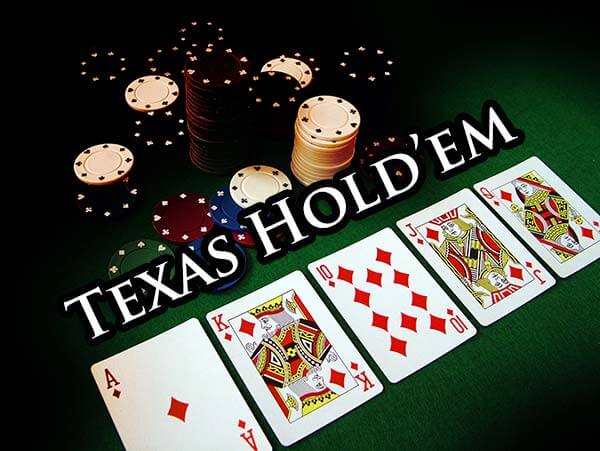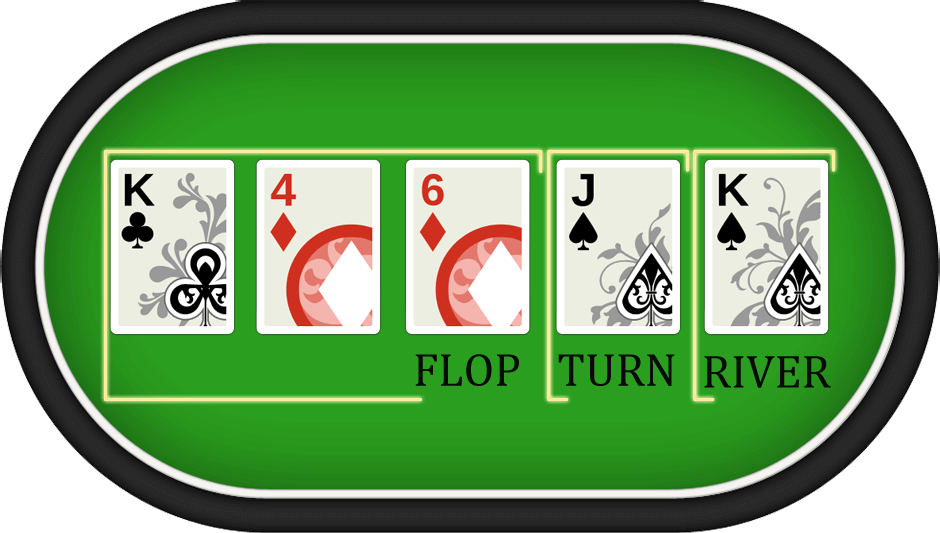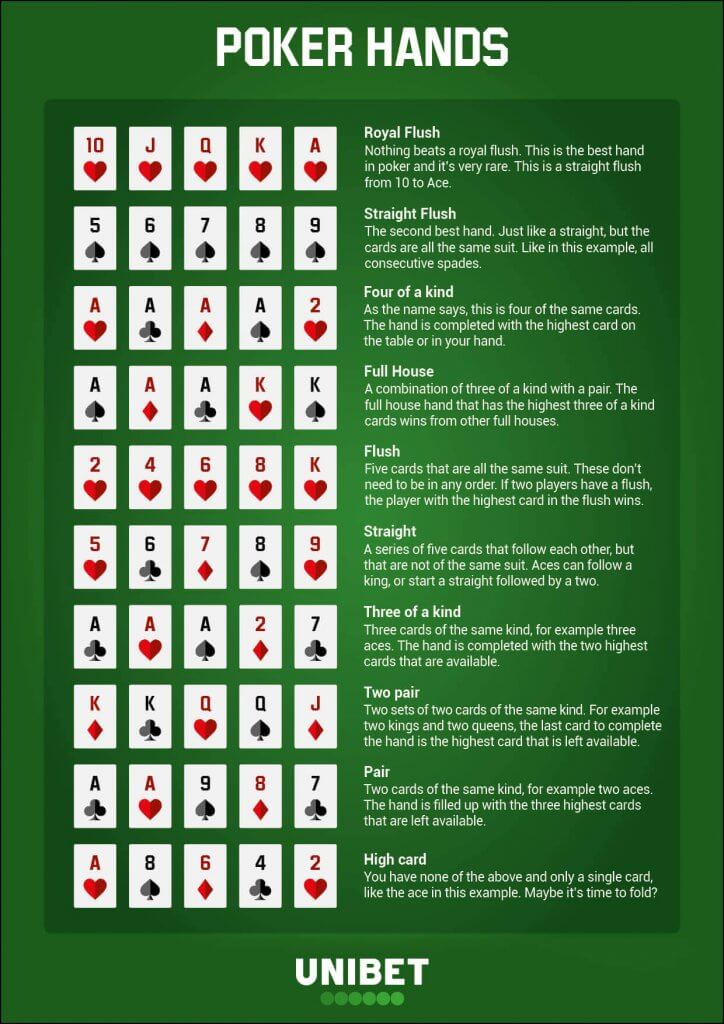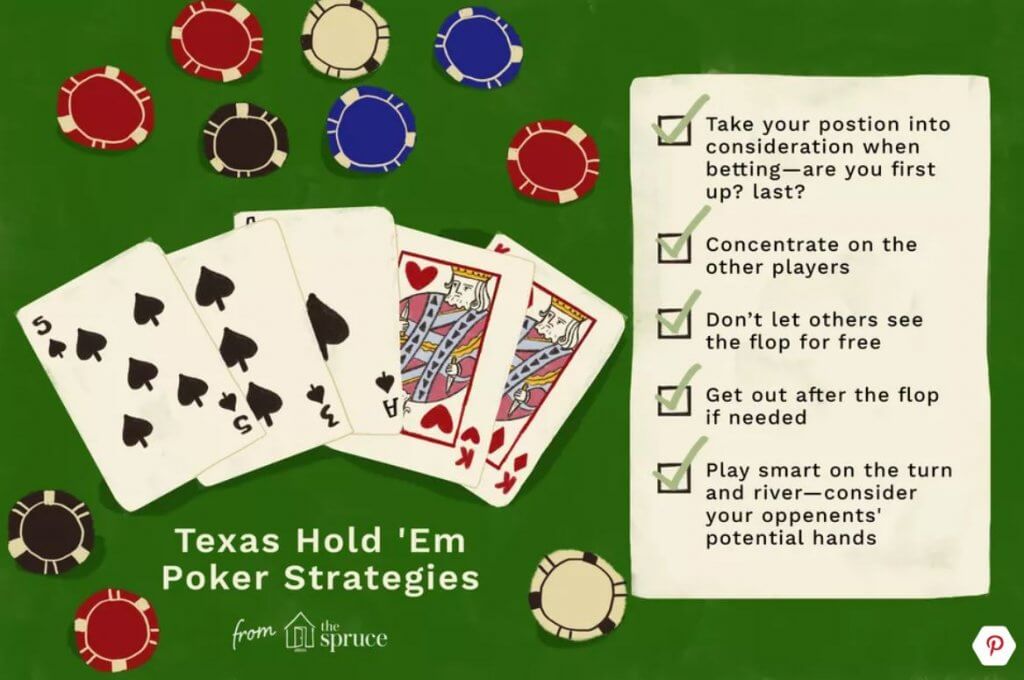Learn How to Play Texas Hold’em
Texas Hold’em is by far the most popular poker game in the world. All the biggest tournaments and cash games such as the WSOP Main Event, which is the Poker World Championship, are played in this format.

The great thing about Texas Hold’em Poker is that it takes only a few minutes to learn. If you want to master the game, it will take a whole lifetime though as it is constantly evolving.
Poker Hand Strengths Guide by VIP-Grinders
That’s why it’s significant to inform yourself and stay up to date with the latest Texas Hold’em poker strategy. We therefore have included the most profitable Texas Hold’em strategy below on this page.
But before we start talking about poker strategy, we will provide a detailed explanation of the Texas Hold’em Rules and Hand Ranking so that you can start playing this fantastic game straight away.
For those, who are playing Texas Hold’em poker online for real money, we have also listed the highest value rakeback deals to maximize your profits here:
Table of Contents
What makes Texas Hold’em the most popular poker variant?
Texas Hold’em poker has become the most popular poker variant due to its perfect balance of simplicity and strategic depth. The rules are easy to learn, making it accessible to beginners, but mastering the game takes years of practice and study.
Its popularity exploded during the poker boom of the early 2000s, largely thanks to televised tournaments like the World Poker Tour and online poker sites.
The no-limit betting structure adds excitement and allows for more creative play, making it a favorite among both casual players and professionals.
Texas Holdem Poker Rules
Let’s kick things off with explaining the Texas Hold’em Rules. At the beginning of a hand, all players are dealt two cards face down, the so-called hole cards, before the first round of betting starts.
Thereafter, five community cards are dealt face up at the poker table in three stages: Flop, Turn and River. Those stages consist of a series of three cards (Flop), followed by two single cards (Turn and River).
The five community cards are dealt in three separate stages:
- Stage 1: The first three community cards are called the Flop
- Stage 2: The Flop is followed by just one card, which is called the Turn, which is followed by another round of betting
- Stage 3: The fifth and final community card is called the River and players can once again check, bet or raise

There are 4 betting rounds: Preflop, Flop, Turn, and River. In each betting round in every poker variant, one player has four different options to check, call, raise, or fold.
The aim of the game is to make the best possible 5-card-poker-hand from any combination of the seven available cards: 2 hole cards + 5 community cards. The player, who shows the best 5-card-poker-hand at showdown, wins the pot.
How do I learn how to play Texas Hold’em effectively?
To learn how to play Texas Hold’em effectively, start by mastering the basic rules and hand rankings. Then, focus on understanding position, pot odds, and hand selection. Study poker strategy books, watch training videos, and analyze hand histories.
Practice regularly in free-play games or low-stakes cash games to gain experience. Join poker forums to discuss hands and strategies with other players. Remember, becoming proficient is a continuous learning process that requires dedication and patience.
How important is position in Texas Hold’em?
Position is crucial in Texas Hold’em. Acting last gives you a significant advantage, as you have more information about your opponents’ actions before making your decision.
This allows you to make more informed choices and potentially steal pots with weaker hands. Late position also enables you to control the size of the pot more effectively.
Conversely, playing from an early position requires a tighter range of starting hands due to the increased likelihood of facing raises from players acting after you.
Poker Hand Ranking
To be able to determine, who has the best five-card poker hand at showdown, you need to know what beats what, which is defined in the hand ranking:

As you can see, there are 10 different kinds of hands a player can have. The best hand is a Royal Flush, which is extremely rare. Even though the high card is just about the weakest hand, it can be enough to win the pot.
Texas Hold’em Gameplay
A white dealer button is used to determine the player in the dealer position. The button rotates clockwise after each hand.
When playing, every player must add something to the pot to keep the game going. Those forced bets called the blinds need to be placed by the two players to the left of the button.
The small blind is posted by the player to the left of the dealer and is usually equal to half of the big blind. The big blind, posted by the player to the left of the small blind and is always double the size of the small blind.
In addition to that, antes or big blind antes, the big blind is posting the antes for the whole table, are now commonly used in both tournaments or cash games to speed up the game flow.
After one betting round (Preflop, Flop, Turn, and River) is finished, the next betting round will start with the person in the small blind.
As soon as the final betting round after the river is finished, all remaining players have to open their hole cards, this is called the Showdown.
At the Showdown, the player with the best possible hand in 5-card-poker according to the above hand ranking wins the pot.
How to play Texas Hold em
As we want to focus on pointing out a winning poker strategy, this is a basic explanation of the Texas Hold ’em Rules, but enough to be able to start playing the game.
For a very detailed and in-depth explanation of the gameplay, please watch the video below:
The different formats of Texas Hold’em
There are four different variations of Hold’em:
- No-Limit Hold’em
- limit hold ’em
- pot-limit hold ’em and
- the relatively new Six Plus Hold’em, also called Short Deck Poker
No-Limit Hold’em is the Cadillac of Poker, as it is by far the most popular poker game. Almost all big tournaments such as the World Series of Poker, EPT, WPT or partypoker Millions and cash games are played in this format.
Six Plus Hold’em, more commonly referred to as Short Deck Poker is based on Texas Hold’em and massively on the rise, especially in Asia as well as in high stakes cash games and tournaments.
Short Deck Poker is played with a deck of 36 cards in contrary to 52 cards in Texas Hold’em, as all cards from 2 to 5 are removed from the deck.
Short Deck is an action-game and frequently generates massive pots. That’s why it’s becoming very popular among cash game players. You can play Short Deck online at partypoker or Natural8 Poker.
Pot-Limit Hold’em can be played online for real money, as well as in a couple of tournaments at the World Series of Poker. The player numbers are considerably lower than in Texas Hold’em though, as there is much less action.
Limit Hold ’em used to be really popular in the 90s in casinos throughout the USA as well as online, but is basically dead nowadays as it is mathematically solved.
What are the key differences between limit and no-limit Texas Hold’em?
The main difference between limit and no-limit Texas Hold’em lies in the betting structure. In limit games, bet sizes are fixed and increase at predetermined points in the hand.
This restricts the amount of money that can be won or lost on a single hand. No-limit games allow players to bet any amount up to their entire stack at any time, creating more opportunities for bluffing and making big plays.
No-limit games tend to be more popular and exciting, while limit games are often considered more mathematically oriented.
How do I approach playing in a Texas Hold’em tournament versus a cash game?
Tournament play and cash games require different strategies in Texas Hold’em. In tournaments, chip preservation and accumulation are crucial as blinds increase over time.
You’ll need to adjust your play based on stack sizes and the tournament stage. In cash games, you can afford to be more patient as the blinds remain constant, and you can always rebuy if you lose your stack.
Cash games also allow for more creative plays and bluffs since there’s less pressure to survive. Tournaments often require a more aggressive approach, especially as the blinds increase.
Texas Hold’em Poker Strategy
The most famous saying about Poker is: “It takes five minutes to learn but a lifetime to master.” We couldn’t agree more, as you never stop learning when playing the game.
If you want to become a successful poker player, the key to success is therefore to work hard and a lot on your game and keep up to date with the latest poker strategy developments.
As you can easily fill a whole website with poker strategy content on Texas Hold’em, we have to stick to the most important strategy advice here.
However, if you follow the steps given below, your results will improve drastically, and you are already on your way to become a winning player.
Here are 4 Golden Texas Hold’em poker strategy tips:
1. Don’t play too many hands!
The by far most essential Texas Hold’em poker strategy advice is to only play the top 15% of hands, as well as to play them aggressively by raising and 3-betting.
By playing only the best 15% of starting hands, you have a huge range advantage against your opponents and can easily avoid making big mistakes postflop. Stick to a tight-aggressive strategy and your results will improve soon!
2. Mind your position at the table
The importance of position can’t be overstated! Playing in position is the way to go, and playing out of position against strong opponents should be avoided at all cost as it will prove costly!
By playing your hands in position, you have a huge informational advantage over your opponents, which you should make consequently make use of by raising frequently on the button or betting small when checked to.

3. Bankroll Management is the key to success
Having a good Bankroll Management is another key to long-term success in poker. Don’t play limits that your bankroll can’t afford, as this is the recipe to go broke.
How do I manage my bankroll when playing Texas Hold’em?
Proper bankroll management is essential for long-term success in Texas Hold’em. As a general rule, have at least 20-30 buy-ins for your chosen stake in cash games.
For tournaments, aim for 100+ buy-ins. Never play with money you can’t afford to lose. Move up in stakes gradually as your skills and bankroll grow.
Be prepared to move down if you hit a downswing. Regularly review your results and adjust your stakes accordingly. Remember, even the best players experience variance, so always play within your means.
4. Never play online poker for real money without a rakeback deal!
If you are not making use of the best rakeback deals on the internet, then you are doing something wrong. Having a high-value rakeback deal is the easiest and fastest way to get an edge over your opponent
Playing online poker for real money without having a rakeback deal means you are missing out on a large amount of free extra cash, which will improve your win rate considerably. Don’t do that!
We have listed the Top 6 Rakeback Deals above. Simply select your favorite online poker site and start earning a lot of extra money today!
3 Important Strategies and Concepts
Let’s look at some key strategies and skills that you should have when playing the game.
1. Bluffing
Bluffing is a crucial skill in Texas Hold’em poker. There are several types of bluffs that players should master:
- Pure Bluffs: These are attempts to win the pot with a hand that has little to no chance of winning if called. Use pure bluffs sparingly and in situations where your opponent is likely to fold, such as when the board texture doesn’t favor their range.
- Semi-Bluffs: These involve betting or raising with a hand that’s not currently the best but has the potential to improve. Semi-bluffs are powerful because they give you two ways to win: by making your opponent fold or by improving to the best hand.
- Continuation Bets: These are bets made on the flop by the preflop aggressor, regardless of whether the flop improved their hand. They’re effective because they maintain the initiative and can win pots when opponents miss the flop.
- Double Barrel Bluffs: These involve betting on both the flop and turn as a bluff. They’re most effective against opponents who tend to call on the flop but fold to turn bets.
- Check-Raise Bluffs: These involve checking intending to raising after an opponent bets. They’re particularly effective in position against aggressive players.
When to use each type of bluff depends on factors like your position, stack sizes, opponent tendencies, and board texture. Always consider these elements before executing a bluff.
2. Hand Reading
Hand reading is a critical skill that separates great players from good ones. Here are some tips to improve your hand reading:
- Pay attention to preflop action: This can narrow down your opponent’s range significantly. For example, a tight player raising under the gun likely has a premium hand.
- Consider board texture: Think about how the community cards interact with your opponent’s likely range. For instance, a coordinated board with many straight and flush possibilities is more likely to have hit your opponent’s range if they called preflop from late position.
- Analyze betting patterns: The size and timing of bets can reveal a lot about hand strength. For example, a quick bet on a draw-heavy board often indicates a strong made hand or a bluff, while a delayed bet might suggest a medium-strength hand.
- Use blockers: If you hold cards that would make strong hands for your opponent, it reduces the likelihood they have those hands.
- Consider player tendencies: Some players always continuation bet, others only bet with made hands. Adjust your reads based on these tendencies.
3. Bet Sizing
Effective bet sizing is crucial for maximizing value and protecting your hand:
- Value bets: When betting for value, size your bets to get called by worse hands. Against loose players, you can bet larger; against tight players, smaller bets might induce more calls.
- Bluffs: Your bluffs should generally be sized similarly to your value bets to avoid giving away information. However, in some situations, larger bluffs can be more effective as they represent stronger hands.
- Protection bets: When you have a vulnerable made hand, bet enough to make it incorrect for drawing hands to call. This is typically around 2/3 to 3/4 of the pot.
- Pot control: Sometimes, smaller bets can keep the pot manageable when you have a good but not great hand. This is particularly useful out of position.
- Exploitative sizing: If you notice opponents folding too much to large bets, you can increase your bet sizes when bluffing against them.
Remember, your bet sizing should tell a consistent story throughout the hand.
How has online poker impacted the game of Texas Hold’em?
Online poker has revolutionized Texas Hold’em, making the game more accessible and allowing players to gain experience rapidly.
It has led to a more aggressive, mathematically oriented style of play due to the ability to play multiple tables simultaneously and use tracking software.
Online poker rooms have also introduced variations like fast-fold poker and time-bank tournaments.
The convenience of playing from home has increased the player pool dramatically, leading to larger tournament fields and more diverse cash game options.
However, it has also presented challenges in terms of game integrity and the need for effective regulation.
What role does psychology play in Texas Hold’em?
Psychology plays a significant role in Texas Hold’em. Reading opponents, controlling your own emotions, and manipulating the perceptions of others are all crucial skills.
Experienced players use tells, betting patterns, and timing to gain information about their opponents’ hands. They also work on their own “poker face” to avoid giving away information.
Understanding concepts like tilt (emotional frustration affecting play) and how to exploit it in others while avoiding it yourself can give you a significant edge in the game.
Tilt Management
Tilt can be a poker player’s worst enemy. Here are strategies to manage tilt:
- Recognize the signs: Increased aggression, playing too many hands, or making irrational decisions are all signs of tilt.
- Take breaks: If you feel yourself tilting, step away from the table for a few minutes to reset your mindset.
- Practice mindfulness: Techniques like deep breathing or meditation can help you stay calm and focused.
- Maintain perspective: Remember that short-term results don’t define your skill as a player. Focus on making the best decisions, not on outcomes.
- Set stop-loss limits: Decide in advance how much you’re willing to lose in a session and stick to it.
- Analyze your play: After sessions where you felt tilted, review your hands to identify and correct mistakes.
Table Image
Your table image can be a powerful tool:
- Cultivate a specific image: You can intentionally play in a way that makes opponents perceive you as tight, loose, aggressive, or passive.
- Exploit your image: Once you’ve established an image, you can make plays that go against that image for maximum effect. For example, if you’ve been playing very tight, a well-timed bluff is more likely to succeed.
- Be aware of your opponents’ perceptions: Your image isn’t just how you play, but how your opponents perceive you. Some players might not be paying attention, while others might have an inaccurate read on you.
- Use table talk strategically: Your conversation at the table can influence how others perceive your play. Be cautious about giving away information.
- Adjust your image: As observant opponents adapt to your play style, be prepared to switch gears and present a different image.
FAQ – Frequently Asked Questions
What are some common mistakes beginners make in Texas Hold'em?
Common beginner mistakes in Texas Hold’em include playing too many hands, calling too often with marginal holdings, and failing to consider position. New players often overvalue suited cards and fall into the trap of “chasing” draws without proper pot odds. Another frequent error is playing passively with strong hands, missing opportunities to build the pot. Beginners should focus on developing a solid preflop strategy and learning to read the board and their opponents’ likely holdings.
What's the significance of the fourth community card (the turn) in Texas Hold'em?
The fourth community card, known as the turn, is a critical street in Texas Hold’em. It’s the point where the betting limits often double in limit games, and in no-limit games, it’s where many big decisions are made. The turn can dramatically change the strength of hands and the texture of the board. It’s often the last chance for drawing hands to improve cheaply, and it’s a key point for value betting with strong hands or bluffing with missed draws.

















